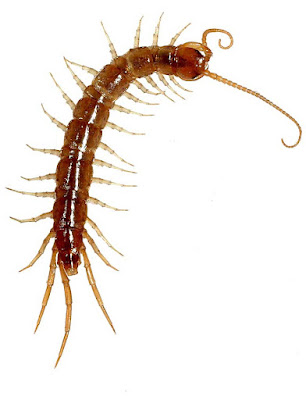This centipede Lithobius forficatus broke cover and raced across the floor when I was shifting some flower pots around in our conservatory in Christmas Day. Centipedes lose water very easily through their exoskeleton, so tend to spend much of their time in crevices and prefer to rest in places where there is something solid above and below them - under a stone (or flowerpot) for example, where their flattened shape allows them to crawl into small spaces. Providing this one with a piece of wet paper to rest on gave it an opportunity to top up its water supply and allowed me just enough time to photograph it before it raced for cover.
It always comes as a bit of a disappointment to learn that there are no centipedes with 100 legs and L.forficatus has a mere 15 pairs. The hind two pairs are much longer than the others and have more of a sensory than a locomotory role, because when the animals wedge themselves in crevices they often have to reverse out - I guess you can think of those long hind legs as the invertebrate equivalent of parking sensors fitted to the rear of expensive cars. For these beautifully articulated animals, reversing out of a narrow gap must be rather like reversing a car with fifteen trailers attached.
Centipedes have very poor eyesight so rely heavily on their antennae for locating food and monitoring their surroundings by touch and smell. Understandably, they take great care of their antennae and this one is drawing the left antenna through its jaws to clean it. The jaws are located out of sight under the head and are separate from those lethal venomous fangs on each side of the head.
Centipedes have one pair of legs per segment, while millipedes have two, but L.forficatus hatches from the egg with only seven segments and seven pairs of legs - additions are made with each moult, until a full complement of 15 segments and pairs of legs is reached.

























Fascinating post Phil.
ReplyDeleteI learnt a lot there.
More learning for me, thank you. I had no idea that they were venomous!
ReplyDeleteThirty legs might make it a trentipede?
ReplyDeleteThis one seems to have a leg missing from the last segment. I assume there is no chance of this re-growing when it moults? Beautiful photographs, as ever.
ReplyDeleteThis is my friend in the garden, as it eats those nasty African snails!
ReplyDeleteThanks Keith, they're fascinating animals, aren't they?
ReplyDeleteHi Toffeeapple, the big tropical species have a dangerous bite but the fangs on ours can't penetrate skin..............
ReplyDeleteWish I'd thought of that Rob!
ReplyDeleteI didn't notice that rmt365 ........ thanks for pointing it out. They can regenerate legs when they moult (like spiders do) although it can take two or three moults for the new leg to reach full size. All the best, Phil
ReplyDeleteHi lotusleaf, I believe they eat our slugs too .... fortunately we don't have any terrestrial molluscs here to compare in size with the African land snails!
ReplyDelete